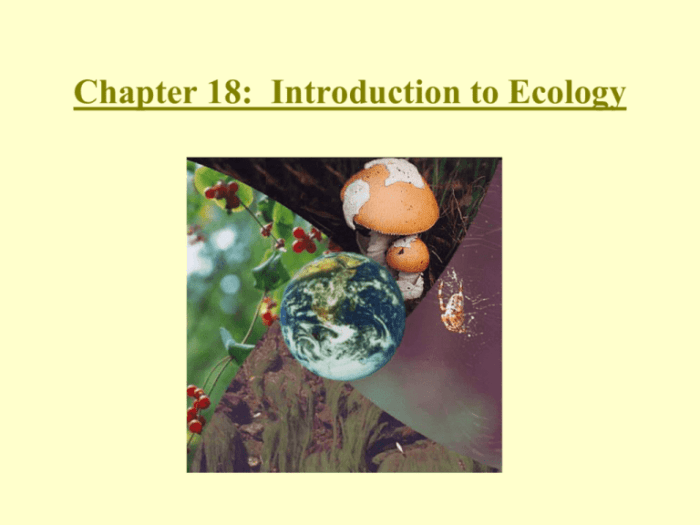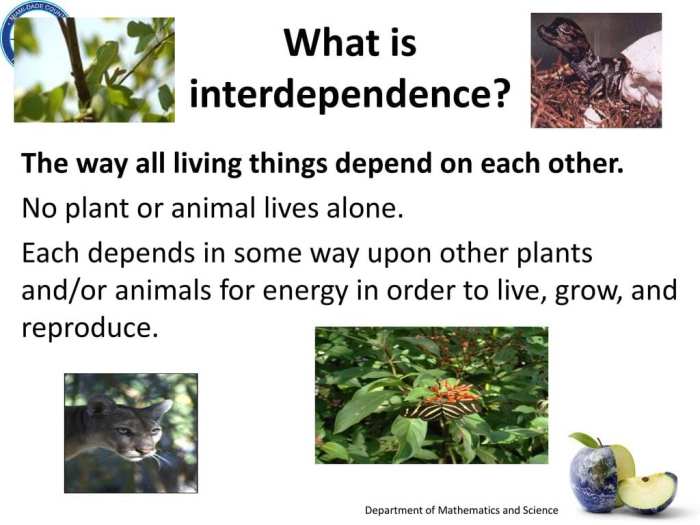Post test the interdependence of ecosystems – Post-test the interdependence of ecosystems, an exploration into the intricate connections that sustain the delicate balance of life on Earth. This analysis delves into the methods, data collection, and implications of understanding how ecosystems function as interdependent units, revealing the profound impact of each component on the overall health and resilience of our planet.
From the smallest microorganisms to the grandest landscapes, every element within an ecosystem plays a vital role in maintaining equilibrium. By conducting post-test analyses, we gain invaluable insights into these intricate relationships, empowering us to make informed decisions for ecosystem management and conservation.
Definition of Ecosystem Interdependence
Ecosystem interdependence refers to the intricate network of connections and relationships between different components of an ecosystem. These components include living organisms, non-living elements, and the physical environment. Each component relies on the others for survival, creating a dynamic and interdependent web of life.
The interdependence of ecosystems is crucial for maintaining the stability and functioning of Earth’s biosphere. It ensures that resources are distributed, energy flows, and ecological processes occur in a balanced manner. Without interdependence, ecosystems would collapse, and life as we know it would cease to exist.
Examples of Ecosystem Interdependence, Post test the interdependence of ecosystems
- Plants rely on sunlight, water, and nutrients from the soil to photosynthesize and produce food.
- Animals depend on plants for food and shelter, and plants depend on animals for pollination and seed dispersal.
- Decomposers break down dead organisms, returning nutrients to the soil and making them available for plants.
- Water cycles through the atmosphere, land, and oceans, supporting life throughout the ecosystem.
Methods for Post-Test Analysis

After conducting an experiment or test on ecosystem interdependence, various methods can be used to analyze the results and draw meaningful conclusions.
Common Methods
- Statistical Analysis:Using statistical tests to compare data sets and identify significant differences or relationships between variables.
- Correlation Analysis:Measuring the strength and direction of relationships between two or more variables.
- Ecosystem Modeling:Creating computer simulations to represent and analyze ecosystem dynamics.
- Field Observations:Collecting data directly from the field to observe changes or patterns in ecosystem components.
Advantages and Limitations
| Method | Advantages | Limitations |
|---|---|---|
| Statistical Analysis | Quantitative data, robust conclusions | Assumptions of normality, may overlook complex interactions |
| Correlation Analysis | Identifies relationships, simple to interpret | Does not imply causation, can be misleading |
| Ecosystem Modeling | Simulates complex systems, predicts future scenarios | Requires detailed data, can be computationally intensive |
| Field Observations | Real-world data, direct evidence | Time-consuming, subject to observer bias |
Data Collection and Analysis
Collecting and analyzing data on ecosystem interdependence is essential for understanding the complex relationships within ecosystems.
Data Collection
- Field Sampling:Collecting data directly from the ecosystem, such as species abundance, vegetation cover, or soil chemistry.
- Remote Sensing:Using satellites or drones to collect data on ecosystem characteristics from a distance.
- Literature Review:Gathering information from existing studies and publications.
Data Analysis
- Descriptive Statistics:Summarizing and describing data using measures like mean, median, and standard deviation.
- Inferential Statistics:Drawing conclusions about the population based on sample data.
- Data Visualization:Creating graphs and charts to represent data patterns and relationships.
Case Studies and Examples

- The Serengeti Ecosystem:A study analyzing the interdependence between herbivores, carnivores, and vegetation, demonstrating the cascading effects of species interactions.
- The Amazon Rainforest:A case study examining the complex relationships between plants, animals, and the water cycle, highlighting the importance of ecosystem services.
- The Great Barrier Reef:An analysis of the interdependence between coral reefs, fish, and marine invertebrates, emphasizing the vulnerability of ecosystems to environmental stressors.
Applications and Implications

Analyzing ecosystem interdependence has numerous applications in real-world scenarios.
| Application | Implication |
|---|---|
| Ecosystem Management | Informing decisions on land use, conservation, and resource management to maintain ecosystem balance. |
| Biodiversity Conservation | Identifying keystone species and vulnerable ecosystems to prioritize conservation efforts. |
| Environmental Impact Assessment | Predicting the effects of human activities on ecosystems and developing mitigation strategies. |
Essential FAQs: Post Test The Interdependence Of Ecosystems
What is the significance of ecosystem interdependence?
Ecosystem interdependence ensures the stability and resilience of natural systems, supporting biodiversity, nutrient cycling, and the provision of essential resources for all life forms.
How can post-test analyses help us understand ecosystem interdependence?
Post-test analyses allow researchers to assess the impact of disturbances or interventions on ecosystem components, providing valuable insights into the strength and resilience of these relationships.
What are some common methods used for post-test analysis of ecosystem interdependence?
Common methods include statistical analysis of species abundance and distribution, network analysis to map interactions, and modeling to simulate ecosystem dynamics.